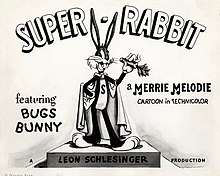Super-Rabbit
Super-Rabbit is a 1943 Warner Bros. cartoon starring Bugs Bunny who is parodying the popular comic book character Superman.[1] Super-Rabbit was the 16th Bugs Bunny entry,[2] and the 47th directed by Chuck Jones.
| Super-Rabbit | |
|---|---|
 | |
| Directed by | Charles M. Jones |
| Produced by | Leon Schlesinger |
| Story by | Tedd Pierce |
| Starring | Mel Blanc Kent Rogers Tedd Pierce |
| Music by | Carl W. Stalling |
| Animation by | Ken Harris |
| Layouts by | John McGrew |
| Backgrounds by | Gene Fleury |
| Color process | Technicolor |
Production company | |
| Distributed by | Warner Bros. Pictures The Vitaphone Corporation |
Release date | April 3, 1943 |
Running time | 8:13 |
| Language | English |
Plot
Professor Cannafraz (a Richard Haydn impression) creates a "super carrot" and uses it on his test subject – Rabbitus idioticus americanus (Bugs Bunny), who immediately wolfs down the proffered carrot. Armed with temporary superhero abilities that need to be replenished with additional super carrots, Bugs remembers a newspaper article about Texas hunter "Cottontail" Smith, who wants to hunt down all rabbits.
Bugs flies to Deepinaharta, Texas, and assumes the moniker of a mild-mannered forest creature, complete with oversized glasses and hat. He encounters Smith, who attempts to shoot Bugs, only for the bullets to form an outline of Bugs before harmlessly falling to the ground. Bugs then hands Smith a cannon, eats another carrot then, upon being struck by the cannonball, plays basketball with it, quickly shoving Smith and his horse onto bleachers while he acts as his own cheerleader. After Bugs returns to the air, the bemused Smith and his horse fly into the sky with their own airplane. Bugs then snatches the shell of the plane away from them, plunging them to the ground.
Bugs runs out of power, but when he tries to recharge again, his carrots fall to the ground. When Bugs lands, he opens his eyes to see a line of chewed-up carrots eaten by Smith and his horse-turned-Superhero. Bugs turns to the camera and says "This looks like a job for a REAL Superman!" He ducks into a phone booth. Both Smith and the horse are ready to attack - until the booth opens and they both snap to attention and salute. Bugs marches out in a Marine uniform, singing the "Marines' Hymn." He dismisses the two, claiming he has "important work to do!", and marches off to "Berlin, Tokyo and points East."[3]
Credits
- Distributor: Warner Brothers
- Producer: Leon Schlesinger
- Supervision: Chuck Jones
- Story: Tedd Pierce
- Animation: Ken Harris
- Robert Cannon (uncredited)
- Ben Washam (uncredited)
- Musical Direction: Carl Stalling
Cast
- Mel Blanc: Bugs Bunny, Cottontail Smith, Texas rabbit
- Tedd Pierce: Observer
- Kent Rogers: Professor Canafrazz
Reception
The U.S. Marine Corps were so thrilled that Bugs Bunny decided to become a Marine in this cartoon that they insisted the character be officially inducted into the force as a private, which was done, complete with dogtags. The character was regularly promoted until Bugs was officially "discharged" at the end of World War II as a Master Sergeant.[4]
Cottontail Smith later appears as one of Yosemite Sam’s sidekicks in Looney Tunes: Back in Action. The character’s voice is a less raucous version of Sam’s and Foghorn Leghorn’s.
Analysis
The short parodies the Superman animated series as a figure soars across the sky from random directions. Onlookers are heard speculating on its nature: "Look! Up there in the sky" "It’s a boid" [bird], "Nah, it ain’t a boid, it’s a dive-bommah".[3][5]
A Marine is described as "a real superman" by Bugs.[3]
Availability
- VHS - Bugs Bunny Cartoon Festival featuring "Hold the Lion, Please"
- VHS and Laserdisc - Bugs and Daffy: The Wartime Cartoons
- VHS - Bugs Bunny On Parade
- VHS - Looney Tunes Collectors Edition: Running Amuck
- Laserdisc - The Golden Age of Looney Tunes Volume 3
- DVD - Looney Tunes Golden Collection: Volume 3
- DVD - Superman: The Ultimate Collection
Sources
- Shull, Michael S.; Wilt, David E. (2004). "Filmography 1943". Doing Their Bit: Wartime American Animated Short Films, 1939-1945. McFarland & Company. ISBN 978-0786481699.
- Weldon, Glen (2013), "...and the American way (1942-1945)", Superman: The Unauthorized Biography, John Wiley & Sons, ISBN 978-1118483787
References
- Beck, Jerry; Friedwald, Will (1989). Looney Tunes and Merrie Melodies: A Complete Illustrated Guide to the Warner Bros. Cartoons. Henry Holt and Co. p. 139. ISBN 0-8050-0894-2.
- Lenburg, Jeff (1999). The Encyclopedia of Animated Cartoons. Checkmark Books. pp. 60–61. ISBN 0-8160-3831-7. Retrieved 6 June 2020.
- Shull, Wilt (2004), p. 157
- Audio commentary by Paul Dini for Super-Rabbit on the Looney Tunes Golden Collection: Volume 3 (2005).
- Weldon (2013), unnumbered pages
External links
| Wikiquote has quotations related to: Super-Rabbit |
| Preceded by Tortoise Wins by a Hare |
Bugs Bunny Cartoons 1943 |
Succeeded by Jack-Wabbit and the Beanstalk |